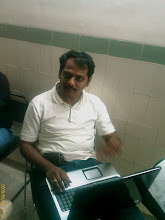Message to readers: Most of the readers of my blog have commented that it is bit difficult to follow the complex topics. hence I have decided to make these blogs simpler. If you think otherwise, please put in your comment and I will take more liberty to write more complex things...
--------------------------------------------------------------------------------------
Yes, globally we are in correction (I don't prescribe to recession, but to correction...) for long now. And all the analysts keep non saying the there is shortage of money supply. But before the correction started, everything was good. Then where did all the money go?
Let us start with understanding role of central banks and macro economic fundamentals. Lets say there are only 2 persons in the economy. They transact using money (or cash bills). As per my earlier post, what ever they pay for is for the effort that they put in. That effort will be converted into cash equivalent based on need and supply. (called demand and supply in a larger context).
Lets say now there is also central bank to control inflation, growth and many more factors. Lets say both these persons have $100 each. that is $200 in the economy. Person A deposits his $100 in the bank. Now bank has $100 to be lent to someone who wishes to start a business. lets say Person B takes that $100 on loan from bank to start his business. Now in economy there are total of $300 ($100 of person A which bank has liability to pay. Person B's $100 and $100 given to person B as loan) In other words now person B has purchasing power of $200, and A with purchasing power of $100.
Lets say person B starts producing goods. He is going to get paid for the efforts. Lets say for some products that person A buys from B, person A pays $50 to person B. Now since bank has to pay $50 to person A, that is typically done by printing new $50 bills (in real world where transactions are mostly bank transfers, central banks dont even need to print money). Now person B can repay his loan of $50 or can reuse the $50 for more business. If he repays his loan, the total cash in economy becomes $250.
This sounds so simple!!!
But a logical question is how does central bank control inflows and outflows in the money market? there is concept of CRR (cash reserve ratio) this basically control the lending % of the banks. So the banks cannot lend all the money which is deposited with them. then the interest rate (repo, reverse repo rates) which defines cost of capital. In today's world I may not be comfortable taking loan at 10% interest. But in booming economy when I have surety of job etc. I may actually take loan at high interest rates.
In times when people are not very optimistic, they tend to repay the loans and not to take more loans and not to spend a lot. All these things siphen away liquidity from the economy
Things can get as complex as you can think with multiple banks, foreign exchanges, multiple people taking decisions based on it and natural issues like earthquakes. If readers ask for, I will talk about more complex things.
Monday, February 23, 2009
Subscribe to:
Post Comments (Atom)

Interesting calculations. However I if by not repaying the loan, the total value increases, then why pay the loan ? :-)
ReplyDeleteGood observation, anonymous. I just wrote about the fact that the money supply keep on changing in the economy based on people's confidence levels and underlying economy itself.
ReplyDeleteI plan to write my next blog "Correction, how did the money go?" to take this topic further.
Good one!
ReplyDelete